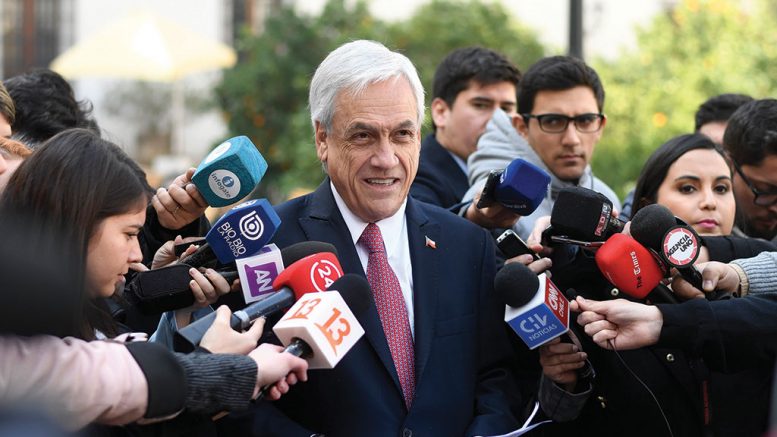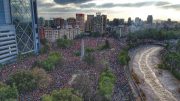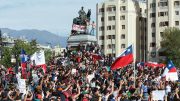Since protests in Chile erupted over a subway fare increase in early October and morphed into broader demonstrations over income equality, inadequate public services and high household debt, at least 26 people have died and 13,500 have been injured.
Of those hurt, more than 220 eye injuries have been documented by Chile’s National Human Rights Institute, an official and independent body. The main cause: pellets fired from 12-millimetre shotguns. The second cause: flying tear gas cartridges.
The Health Ministry reported on Nov. 17 that 16 people have lost eyesight in one eye and 34 others had “severe eye injuries that could result in partial or total eyesight loss,” Human Rights Watch outlined in a Nov. 26 report calling for police reform.
“For at least 12 victims, the damage to the cornea, iris and optic nerve has been so severe that doctors have had to remove the eye completely,” the New York Times reported in November. “A bandaged eye is now so common among people protesting inequality in Chile that it has become a rallying symbol.”
The newspaper’s reporters documented visiting the waiting room of a local hospital.
“An 18-year-old mechanics student lay on a stretcher worried whether the pellet inside her closed and swollen left eye would leave her blind,” the paper wrote. “A 46-year-old ironworker who was protesting the low minimum wage waited for an implant in his now empty right eye socket. A mother wiped a trickle of blood seeping from her son’s new prosthetic eye as he described the moment a police officer shot him.”
Human Rights Watch said the use of shotguns “that scatter pellets indiscriminately over a wide area with the potential to harm anyone in their path is of particular concern … While initially concentrated within a small radius as they are fired, the pellets contained in the cartridges expand away from each other, to create a constellation of projectiles that can reach several decimetres in radius within a few metres of being fired.”
Often called “rubber bullets” — the pellets are actually “as hard as the wheel of a shopping cart,” HRW says.
A team of independent experts appointed by the United Nations Human Rights Council claimed on Nov. 8 that “the high number of wounded and the way in which non-lethal weapons have been used seem to indicate that the use of force was excessive and violated the requirements of necessity and proportionality.”
Chile’s police force finally suspended the use of “non-lethal” pellets on Nov. 19 — a day after a study by the mechanical engineering faculty at the University of Chile said 80% of the pellets are silica, barium sulphite and lead, and only 20% rubber.
HRW points to 442 criminal complaints through Nov. 21 that have been filed with prosecutors on behalf of victims “alleging police-inflicted injuries, cruel treatment, torture, sexual violence, attempted killings, and killings.” The Attorney General’s office is investigating 26 deaths. “There are hundreds of worrying reports of excessive force on the streets and abuse of detainees,” states Jose Miguel Vivanco, HRW’s America’s director. “This is precisely why police reforms are urgently needed.”
But police reform is just a start. Much more needs to be done. In terms of income inequality, the Organization for Economic Cooperation and Development ranks Chile as the most unequal of its 36 member states. President Sebastian Pinera has promised a referendum in April 2020 on writing a new Constitution to replace the one penned more than 40 years ago under Chilean dictator Augusto Pinochet (see story on Page 6). Pinochet, with input from U.S. free-market economists from Chicago, embarked on cuts to social spending and a massive privatization spree of state businesses, many of which ended up in hands of the country’s elite. Mining giant SQM was acquired by a group of investors led by Pinochet’s former son-in-law, Julio Ponce Lerou.
“Today, the country’s wealth is largely in the hands of a few families who own mining, retail, finance, forestry, and other interests,” the Wall Street Journal reports. “Two supermarket chains account for about two-thirds of retail sales, three pharmacies have 95% of that market, and three private companies manage the pension funds of more than three-quarters of the country’s contributors.”
Pinera, whose net worth is US$2.8 billion according to Forbes, declared during a state of emergency address on Oct. 18 that the country is “at war against a powerful enemy.”
But lower- and middle-income Chileans say it’s time for change and a new social contract.




Be the first to comment on "Editorial: Use of force against protesters in Chile alarms UN, Human Rights Watch"